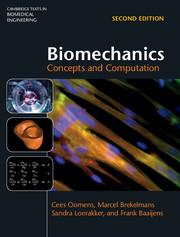
-
Select format
-
- Publisher:
- Cambridge University Press
- Publication date:
- 02 February 2018
- 08 February 2018
- ISBN:
- 9781316681633
- 9781107163720
- Dimensions:
- (246 x 189 mm)
- Weight & Pages:
- 1.06kg, 420 Pages
- Dimensions:
- Weight & Pages:
You may already have access via personal or institutional login- Subjects:
- Life Sciences, Engineering, Bioengineering, Biomedical Engineering
Book description
Thoroughly revised and updated for the second edition, this comprehensive textbook integrates basic and advanced concepts of mechanics with numerical methods and biomedical applications. Coverage is expanded to include a complete introduction to vector and tensor calculus, and new or fully updated chapters on biological materials and continuum mechanics, motion, deformation and rotation, and constitutive modelling of solids and fluids. Topics such as kinematics, equilibrium, and stresses and strains are also included, as well as the mechanical behaviour of fibres and the analysis of one-dimensional continuous elastic media. Numerical solution procedures based on the Finite Element Method are presented, with accompanying MATLAB-based software and dozens of new biomedical engineering examples and exercises allowing readers to practise and improve their skills. Solutions for instructors are also available online. This is the definitive guide for both undergraduate and graduate students taking courses in biomechanics.
Reviews
'The increased number of exercises and examples used to bring the lectures alive and to illustrate the theory in biomedical applications make this second edition of the book Biomechanics: Concepts and Computation definitely the reference to teach classical concepts of mechanics and computational modelling techniques for biomedical engineers at Bachelor level. The authors from Eindhoven University of Technology belong to one of the most prestigious Departments of Biomedical Engineering around the world, with a well-recognized expertise in Soft Tissue Biomechanics and Tissue Engineering. I have no hesitation in recommending that book that should be a prerequisite for any student studying biomechanics.'
Yohan Payan - Director of Research at Centre National de la Recherche Scientifique (CNRS), Université Grenoble Alpes
'A comprehensive textbook for learning all important concepts of biomechanics and their possible applications in sports and medicine. Students will enjoy the opportunity of learning computational modeling in biomechanics from scratch, needing only basic mathematical background. Instructors will appreciate the endless source of problems all resulting from successful experiences of teaching in the authors’ career. Definitely recommended in every library.'
Stéphane Avril - École des Mines, St Étienne
'Biomechanics: Concepts and Computation remains one of the strongest textbooks ever written in the field of biomechanical education. The theory in the book is thorough and rigorous, and is extremely well illustrated with numerous excellent exercises. I find the chapters describing numerical implementation and finite element formulations especially useful for translating the theory of tissue mechanics to bioengineering practice. I am using this book routinely in my undergraduate and graduate courses and will continue to do so with this second edition.'
Amit Gefen - Tel Aviv University, Israel
Contents
Metrics
Altmetric attention score
Full text views
Full text views help Loading metrics...
Loading metrics...
* Views captured on Cambridge Core between #date#. This data will be updated every 24 hours.
Usage data cannot currently be displayed.
Accessibility standard: Unknown
Why this information is here
This section outlines the accessibility features of this content - including support for screen readers, full keyboard navigation and high-contrast display options. This may not be relevant for you.
Accessibility Information
Accessibility compliance for the PDF of this book is currently unknown and may be updated in the future.


